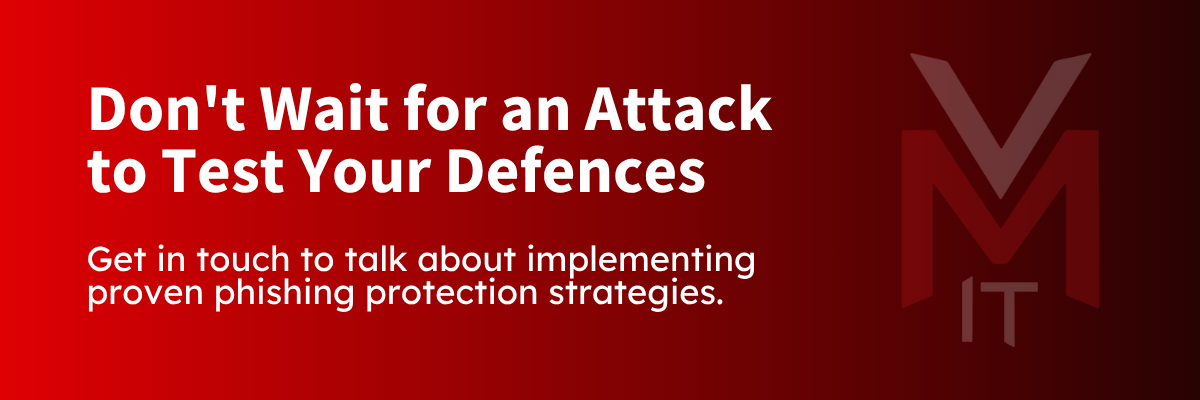Today, we’re talking phishing – no, not the outdoor activity that takes place along a river. This kind is an electronic communication claiming to be from someone you know and trust. Behind it lies a cybercriminal with the intent to steal your sensitive business information.
Here’s how to avoid falling for these common scams hook, line, and sinker.
Phishing 101: What Every Business Owner Needs to Know
Phishing protection for businesses starts with understanding the threat.
The term ‘phishing’ comes from an analogy of an angler casting a hook with bait, hoping you’ll “bite”. In digital terms, attackers send fraudulent communications that appear legitimate, encouraging recipients to click malicious links or share confidential information.
It’s arguably the most popular cyber-attack technique – in 2024, nearly 35% of all security breaches involved phishing, and you’ll no doubt have seen the attack on M&S making headlines earlier this year. That’s right – even big companies are falling victim.
The reason? Modern phishing has evolved far beyond simple email scams. Today’s cybercriminals leverage artificial intelligence, social engineering, and sophisticated impersonation techniques. Simply keeping an eye out for poor spelling and unknown senders isn’t enough to keep businesses protected anymore.
How Modern Phishing Attacks Work
Contemporary phishing attacks typically follow this pattern:
- Target Selection: Attackers research your business, employees, and commonly used services
- Content Creation: They replicate legitimate websites and communications (with remarkable accuracy)
- Delivery: Malicious content is delivered via email, text, or even phone calls
- Data Harvesting: Once victims interact (clicking on a link of attachment or entering login information on a fake web page), credentials and sensitive information are captured
- System Exploitation: Stolen credentials provide access to business systems and data. Since the attacker is posing as a legitimate user, they won’t raise any red flags within lacking security systems. They can sit undetected for months, gathering data and intel or quietly modifying permissions.
What makes attacks particularly dangerous in 2025 is their sophistication. Attackers can now create pixel-perfect replicas of legitimate services, use AI to craft highly personalised messages, and exploit current events or business relationships to appear credible.
Spear Phishing vs. General Phishing: Why You Need to Know the Difference
While general phishing casts a wide net, spear phishing targets specific individuals or organisations with the aforementioned personalised attacks. These focused campaigns are particularly dangerous for local businesses because they:
- Reference specific employees, projects, or business relationships
- Appear to come from trusted partners or internal colleagues
- Exploit knowledge of your business operations and technology
- Often bypass standard email security filters due to their personalised nature
Norfolk teams in regulated industries like legal and financial services are especially attractive targets for spear phishing due to the valuable data they handle.
Recognising Phishing Attempts: Warning Signs for Your Team
Ever heard the saying that a police officer’s nose can detect trouble from afar? We wish it was that simple to detect a phishing email, too. Unfortunately, there are no hard and fast rules, as the line between genuine and fake emails can be blurry.
Developing cyber security awareness across your organisation means you’ll have to repeatedly train your team to spot common warning signs:
Email-Based Indicators:
- Requests for sensitive information via email
- Unexpected urgency or threats of account suspension
- Generic greetings like “Dear Customer” instead of your actual name
- Suspicious sender addresses that don’t match the claimed organisation
- Mismatched URLs when you hover over links
Behavioural Red Flags:
- Unsolicited requests for login credentials or financial information
- Pressure to act immediately without time for verification
- Communications about services you don’t use
- Requests to download unexpected attachments or software
Remember that legitimate organisations, including Norwich cyber security services like VMIT, will never ask for passwords or sensitive information via email.
The Cost of Phishing: Why Prevention Matters
When we talk about the impact of phishing, most business owners immediately jump to the financial losses – fraudulent transactions, ransom payments, recovery costs and the like. But it’s important to consider all the other potential consequences:
- Business interruption and lost productivity
- Increased insurance premiums
- Regulatory scrutiny and compliance costs
- Competitive disadvantage from lost intellectual property
- Damaged reputation and lost customer trust
For Norfolk’s small and medium businesses, a single successful attack can be devastating. The financial impact varies significantly based on business size and industry, but even smaller incidents can result in substantial costs that many businesses struggle to absorb.
Essential Phishing Protection Strategies for Your Business
1. Implement Multi-Layered Email Security
Effective phishing protection for businesses requires multiple security layers:
- Advanced email filtering that analyses content, sender reputation, and link destinations
- Anti-malware solutions that scan attachments in real-time
- URL protection that checks links before allowing access
- Sandboxing technology that safely analyses suspicious content
Should one layer fail, the others can still keep hackers out.
2. Establish Strong Authentication Protocols
Two-factor authentication (2FA) serves as a critical safety net. Even if credentials are compromised through phishing, 2FA can prevent unauthorised access to your systems. We recommend implementing 2FA across:
- All email accounts and cloud services
- Business applications and databases
- Remote access systems and VPNs
- Administrative accounts and privileged access
3. Create a Security-Conscious Culture
Cyber security awareness has to become part of your business DNA. It’s not something most people will keep front of mind, so it’s your responsibility to work with professional security services in Norwich to:
- Conduct regular phishing simulation exercises
- Provide ongoing training about emerging threats
- Establish clear protocols for reporting suspicious communications
- Encourage questions rather than penalising mistakes
- Regularly update your team on new attack methods
4. Implement Verification Procedures
Finally, develop standardised processes for verifying unusual requests:
- Always verify payment requests or account changes via a separate communication channel
- Call suppliers directly using known contact details
- Establish code words or procedures for sensitive requests
- Require multiple approvals for significant financial transactions
- Create escalation procedures for suspicious communications
What Are the Best Anti-Phishing Tools for Small Businesses?
Professional cyber security services can advise you on the right anti-phishing tools for your needs. They might include things like:
Email Security Platforms:
- Advanced threat protection with machine learning capabilities
- Real-time link analysis and safe attachment opening
- Impersonation detection for executive and vendor spoofing
- Automated incident response and quarantine features
Password Management Solutions:
- Encrypted password storage with secure sharing
- Automated password generation and rotation
- Single sign-on integration to reduce credential exposure
- Breach monitoring and alert systems
And Security Awareness Training Platforms:
- Simulated phishing campaigns tailored to your business
- Interactive training modules covering current threats
- Progress tracking and reporting for compliance purposes
- Customisable content relevant to your industry
What to Do If You Think You’ve Clicked on a Phishing Link
Every business needs a clear response protocol when phishing attempts are detected. In the short term, the most important thing is not to panic. Assessing the situation calmly and systematically will help you contain the incident more effectively.
Then, you’ll need to:
- Isolate: Disconnect affected systems from your network if compromise is suspected
- Document: Record all relevant details about the attack
- Report: Notify your IT support team and relevant authorities
- Communicate: Inform affected stakeholders following your communication plan
This becomes much easier if you’ve got a managed cyber security team to assist you. They can handle post-incident analysis and ensure your security measures are properly updated based on the lessons learnt.
Take Action to Strengthen Your Defences Today
Effective phishing protection isn’t about achieving perfect security – it’s about making your business a harder target than your competitors while building resilience to recover quickly from any incidents that do occur.
Ready to strengthen your business against phishing threats? Contact VMIT today for a consultation and discover how our people-first approach to business cyber security can protect your Norfolk business from evolving cyber threats.


